#Tukaram
Explore tagged Tumblr posts
Note
aapko kya tag du?
Kehte to log humko Sharmaji hai idhar. Aapko Jo mann rakh lo naam
#tmkoc fan ji#aka#... ummm kiske upar rakhe tag?#ekamev secretary atmaraam tukaram bhide ya humare relatability ke devta jethiya
9 notes
·
View notes
Text
Best Home Appliances Shop in Tukaram Nagar, Dombivli

Your Go-To Destination for Home Appliances in Tukaram Nagar, Dombivli
When it comes to shopping for home appliances, residents of Tukaram Nagar, Dombivli, have a gem of a store right in their neighborhood. Kohinoor Video Vision is not just any electronics products shop; it's the best home appliances shop in Tukaram Nagar, Dombivli. Offering a wide range of high-quality appliances and unmatched customer service, Kohinoor Video Vision has become the preferred choice for households seeking to upgrade their living spaces.
One of the standout features of Kohinoor Video Vision is its extensive and diverse selection of home appliances. Whether you're in the market for a new refrigerator, washing machine, television, air conditioner, or any other electronic device, you'll find top brands and the latest models right here. We ensure that their inventory is up-to-date, allowing customers to choose from the most technologically advanced and energy-efficient appliances on the market.
Affordability is a significant factor when purchasing home appliances, and We understands this well. They strive to offer competitive prices without compromising on quality. Plus, they frequently run special offers and promotions, making it even more budget-friendly to shop for the appliances you need. Keep an eye out for their seasonal discounts and bundle deals, which can save you a substantial amount on your purchases.
One of the key reasons why Kohinoor Video Vision stands out as the best home appliances shop in Tukaram Nagar, Dombivli, is their commitment to customer service. Their knowledgeable and friendly staff are always ready to assist you in finding the right appliances for your specific needs. Whether you have questions about product features, energy efficiency, or installation, they have the expertise to guide you through the decision-making process.
Located in the heart of Tukaram Nagar, Dombivli, Kohinoor Video Vision is easily accessible to residents of the area. Its central location ensures that you don't have to travel far to access a wide range of home appliances. Additionally, the store's welcoming ambiance and organized layout make the shopping experience a breeze.
Kohinoor Video Vision doesn't just stop at selling you the appliances; they also prioritize after-sales service. Their commitment to customer satisfaction extends to providing warranty support and repair services for the products they sell. You can rest assured that your investment is protected, and if any issues arise, their team is just a phone call away.
When you're on the lookout for the best home appliances shop in Tukaram Nagar, Dombivli, look no further than Kohinoor Video Vision. With their extensive range of high-quality appliances, competitive prices, expert guidance, and exceptional customer service, they have earned a reputation as the go-to destination for all your home appliance needs. Visit Kohinoor Video Vision today to discover the perfect appliances that will enhance your home and make your life more convenient.
0 notes
Video
youtube
Tukaram Maharaj Gatha Abhang 136 ऐसा हा लौकिक कदा राखवेना । पतितपावना दे...
#youtube#sant tukaram maharaj gatha abhang ram shrijagadguru charan तुकाराम गाथा अभंग vithal haripath bhajan
1 note
·
View note
Text

सुंदर तें ध्यान उभे विटेवरी ।
कर कटावरी ठेवोनियां ॥१॥
Beautiful is that vision/thought (of Vitthala) standing on the brick with his hands
तुळसी हार गळां कांसे पीताम्बर ।
आवडे निरंतर तेंचि रूप ॥२॥
Adorned with Tulasi garlands and Pitaambara. I am always fond of his form.
मकरकुंडलें तळपती श्रवणीं ।
कंठीं कौस्तुभमणि विराजित ॥३॥
He adorns his ears with fish-like earrings. The kaustubha gem rests around his neck.
तुका ह्मणे माझें हेंचि सर्व सुख ।
पाहीन श्रीमुख आवडींने ॥४॥
Thus, Tuka says, this is all my happiness (that I seek)
I will behold his auspicious visage with great joy.
- Saint Tukaram.
*********
Wishing everyone a prosperous and blessed Ashadhi Ekadashi. May Vitthala and Rakhumai always be with you. This composition by Saint Tukaram resonates with each and every devotee who seeks their joy in Vitthala / Naryana. I have tried to translate it as precisely as I could with whatever little knowlege of Marathi that I have. You can let me know if I have made a mistake somewhere.
🐚🪷 ।। रामकृष्ण हरी ।। 🪷🐚
31 notes
·
View notes
Text
Why Murti Pooja(Idol Worship) is important in Hinduism?
Murti pooja holds great importance in Hinduism. It is essential to understand that murti pooja is the initial stage in the path of devotion (bhakti marg). Unfortunately, it is often criticized by non-Hindus, largely due to ignorance. However, it is a profound way to reach God, with murtis acting as a medium for connection. Hinduism has long emphasized that God exists both in a formless (nirakara) and a form-based (sakara) state. For those who struggle to comprehend the formless aspect of God, murti pooja provides a meaningful way to express their devotion. Even great saints like Shri Ramakrishna Paramahamsa practiced murti pooja of Maa Kali, demonstrating its spiritual significance.

The practice of Murti Puja (idol worship) holds significant importance in the teachings of various saints, though their perspectives vary based on their philosophical and spiritual outlooks. For many, murti puja serves as a bridge between the formless Divine and the human need for tangible representation. Saints across traditions have explained its value, while some have cautioned against its misuse when done without true devotion.
Shri Adi Shankaracharya, the proponent of Advaita Vedanta, emphasized the ultimate realization of the formless and non-dual reality, Brahman. However, he acknowledged murti puja as a necessary practice for beginners. He taught that worshipping idols helps focus the mind and develop devotion, which ultimately leads one to transcend the form and realize the Divine essence.
Shri Ramanujacharya, a key figure in Vishishtadvaita Vedanta, embraced murti puja as a vital spiritual practice. He taught that God exists both as the immanent and transcendent reality, making the worship of His personal form through murtis a meaningful expression of devotion. For Shri Ramanujacharya, murti puja was a way to build a personal relationship with the Divine, an integral part of bhakti or devotional worship.
Chaitanya Mahaprabhu, a pioneer of the Vaishnava tradition, saw murti puja as a profound means to connect with Lord Krishna. He regarded Krishna’s murti as non-different from Krishna Himself and encouraged worship infused with pure love and devotion. According to Chaitanya, sincere murti puja allows the devotee to feel the presence of the Divine and serve Him directly.
Swami Vivekananda explained the psychological and spiritual significance of murti puja. He defended the practice, arguing that idols serve as tools to concentrate the mind on higher ideals. For Vivekananda, murti puja was not about the idol itself but about the devotion and focus it inspires in the worshipper.
Saints from the Varkari tradition, such as Eknath and Tukaram, placed great importance on murti puja, especially in their devotion to Lord Vithoba. They saw murtis as a medium for constant remembrance and surrender to God. Through heartfelt worship, the devotee's love for the Divine grows, leading them closer to liberation.
Ramakrishna Paramahamsa also upheld the practice of murti puja as a valid and meaningful form of worship. He believed that for beginners, the Divine’s tangible form helps establish a connection with God. Over time, this devotion deepens, and the worshipper transcends the form to realize the formless Divine. He often stated that idols are not mere objects but living representations of God that respond to sincere prayers.
In essence, murti puja is seen by many saints as a stepping stone in the spiritual journey, helping devotees channel their focus and devotion. So, Murti Pooja definitely helps in moving towards Moksha.
7 notes
·
View notes
Text
⚖️ परिचय ⚖️
Johaar! Namaste! Kon’nichiwa Everybody!
आपका तहे दिल से स्वागत है Desi Tumblr ke ek chhote se page pe... Main hoon aapke iss safar ka मेज़बान aur दोस्त Dr. SubbRee...
Waise toh mera shubh naam ऋषभ hai parr aap mujhe kisi bhi naam se bula sakte ho... 🌛✨
Likhne ka bada shauq hai mujhe (kyunki accha likhta hoon) aur daydreaming karne ka bhi... ☠️
He/Him aur 19 age hai "एकाकी लेखक"
Bollywood buff hoon iseliye Hopeless Romantic hoon... Life ki pareshani ne DevDas bana diya hai... Baiju Bawara ke jaisi Musical Taste mein saare gunn bhare hue hai... Aur Icebear ki tarah awkward jokes bhi crack kar leta hoon (Atmaram Tukaram Bhide is my mirror image)
Hopeless Romantic, Baiju Bawara, DevDas, Chowpatty Ka Icebear, yeh saare mere personas hai... Iseliye accordingly unke alag alag pages hai @baiju-bawara @dev-das @chowpatty-ka-icebear
Medical Aspirant hoon iseliye pardhne likhne ka kaafi shauq hai (roz ncert jo pardhta hoon) Kafka, Dovesktysy, Chekhov, Premchand, Swami Vivekananda, Tagore are my comfort reads...
मेर��� Dil और dms सदैव aapke liye khule hue hai... drop by em anytime... you won't be disappointed i can promise you that... 💫🙈
thenks for reading. 🤗 ciao!
35 notes
·
View notes
Text
"Beyond the Mirage: Breaking Free from Worldly Illusions"

In the doha, “Jaga sukha jara, moha ti chhedu” Saint Tukaram offers a powerful reflection on the nature of worldly happiness. The line translates to “Worldly happiness is temporary, cut through the illusion.” Tukaram presents a direct challenge to our usual understanding of happiness, urging us to move beyond the fleeting joy that material things and desires bring. This doha provides a roadmap for spiritual awakening by encouraging detachment from illusions and a deeper exploration of true, lasting joy.
1. The Fleeting Nature of Worldly Happiness: Worldly pleasures are often pursued as the ultimate goal in life—wealth, recognition, material success, or sensory pleasures. While these may bring a momentary sense of joy, Tukaram reminds us that they are temporary, much like a mirage in a desert. This happiness, bound to the material world, fades as quickly as it arrives, leaving us in constant pursuit of more.
From a spiritual standpoint, chasing these transient pleasures only distracts us from realizing our true nature, which is eternal and beyond material confines. This is why Tukaram calls this happiness an illusion—an image we constantly chase but never truly grasp.
2. Breaking the Chains of Illusion (Moha): Tukaram’s call to "cut through the illusion" speaks to the core of spiritual awakening. Illusion, or "moha," in this context, refers to our attachment to the material world and the belief that it holds the key to our happiness. The doha encourages us to recognize that the attachments we form to people, objects, and achievements are based on illusions created by our desires. These attachments become chains, binding us to a never-ending cycle of temporary joy and inevitable dissatisfaction.
3. Discovering Eternal Bliss: Tukaram points us toward a higher truth—the joy that comes from realizing our connection to the divine, the universe, or the eternal essence within us. This joy is not dependent on external circumstances. It is stable, constant, and available to all who are willing to look beyond the material and cultivate spiritual awareness.
Instead of fleeting happiness, we can tap into a deeper state of bliss through practices like meditation, self-inquiry, and devotion. This bliss is unaffected by the highs and lows of worldly experiences because it is rooted in the unchanging reality of the self.
4. A Different Perspective on Life: This doha challenges the conventional idea that life’s purpose is to seek happiness through external achievements or possessions. It suggests that true contentment is not found in what we gain but in what we let go of. This idea is revolutionary in a world that promotes acquisition, consumption, and ambition as paths to fulfillment. Tukaram flips this perspective, offering a path of renunciation, detachment, and inner reflection as the key to real joy.
Practical Toolkit for Daily Routine:
To incorporate Tukaram's wisdom into daily life, here’s a practical toolkit designed to help cut through the illusions of the material world and cultivate a sense of inner peace and lasting joy.
1. Mindful Reflection on Desires:
Each day, take 10 minutes to sit quietly and reflect on your desires. Ask yourself: “Is this bringing me lasting happiness or momentary pleasure?” This reflection will help you become aware of the illusory nature of many desires.
2. Daily Detachment Practice:
Choose one small material attachment or habit to let go of for the day. This could be something as simple as avoiding social media for a few hours or not indulging in a particular craving. This practice strengthens your ability to detach from illusions.
3. Meditation on True Bliss:
Practice a daily meditation where you focus on the concept of eternal bliss. Visualize yourself as a being of peace and contentment, untouched by external circumstances. This visualization reinforces your connection to lasting joy.
4. Gratitude for What Is:
Instead of focusing on what you don’t have, cultivate gratitude for what is present in your life. This shift in perspective can help dissolve the illusion that happiness comes from gaining more. Begin or end each day by listing three things you are grateful for.
5. Service Without Expectation:
Engage in acts of service or kindness without expecting anything in return. This helps to break the cycle of attachment to results and shifts your focus from material gain to spiritual fulfillment.
6. Mantra Practice:
Recite a simple mantra each morning, such as “Om Shanti” (I am peace) or “Sat Chit Ananda” (Truth, Consciousness, Bliss), to anchor yourself in the reality of eternal joy. Chanting these mantras can help dissolve illusions and foster a deeper connection to inner peace.
7. Simplify Your Environment:
Create a clutter-free and peaceful space in your home where you can engage in spiritual practices. Reducing physical clutter helps clear mental clutter, making it easier to see through the illusions of material attachment.
8. Engage in Conscious Consumption:
Before buying something, ask yourself if it is a need or a desire. This small pause can help you become more aware of how often we chase fleeting happiness through material goods. It also reinforces the practice of detachment.
9. Spiritual Study:
Dedicate time each week to read spiritual texts or listen to teachings that focus on breaking free from illusion. Reflect on how the wisdom can be applied to your own life and incorporate it into your practices.
10. Regular Digital Detox:
Once a week, take a break from digital distractions—social media, online shopping, or entertainment. Use this time to reconnect with nature, meditate, or engage in creative pursuits that bring you joy from within, rather than from external sources.
Looking Ahead
Tukaram’s doha, "Jaga sukha jara, moha ti chhedu," serves as a spiritual wake-up call. It urges us to see through the mirage of worldly happiness and realize that true joy lies within, untouched by material gains or losses. By cultivating detachment, practicing gratitude, and engaging in spiritual practices, we can cut through the illusions that keep us bound to temporary happiness and discover the boundless, eternal bliss that is our true nature.
#SpiritualAwakening#TukaramTeachings#BreakIllusions#InnerPeace#TrueHappiness#EternalBliss#DetachFromDesires#SpiritualGrowth#SeekTruth#MindfulLiving#SoulfulJourney#SpiritualWisdom#InnerFulfillment#ConsciousLiving#TranscendIllusions#AGImageAI
3 notes
·
View notes
Text
Sufinama: A Journey Through the World of Sufism
Sufinama: A Journey Through the World of Sufism
Sufism, an ancient mystical tradition, transcends boundaries of time and space, encompassing poets, saints, and seekers of divine love. In this comprehensive guide, we embark on a journey through the rich tapestry of Sufinama, exploring its diverse facets, from poetry and music to spiritual teachings and stories. Let us delve deep into the essence of Sufism and unravel its timeless wisdom.
Poetic Gems of Sufism: Sufi poetry, with its sublime beauty and profound symbolism, serves as a beacon of light for seekers on the path of love and devotion. From the ecstatic verses of Rumi and Hafiz to the soul-stirring couplets of Kabir and Bulleh Shah, explore the transcendent power of words that echo the longing of the human soul for union with the Divine.
1. Sufis/Sants: The luminous souls known as Sufis or Sants exemplify the highest ideals of love, compassion, and humility. Through their exemplary lives and teachings, they illuminate the path of spiritual awakening and inspire countless seekers to tread the path of inner transformation.
2. Sant Vani: Sant Vani, the divine utterances of saints, resonates with the eternal truths of existence. Immerse yourself in the timeless wisdom of Sant Kabir, Sant Tukaram, and other revered saints as they impart profound insights into the nature of reality and the essence of divine love.
3. Sufi Qawwali: Sufi Qawwali, the soul-stirring devotional music, transports listeners to realms beyond the mundane, awakening the heart to the ecstasy of divine love. Experience the mesmerizing melodies and ecstatic rhythms that characterize this rich musical tradition, celebrating the union of lover and Beloved.
4. Sufi Kalam: Sufi Kalam, the mystical poetry set to music, serves as a vehicle for spiritual transformation and transcendence. Delve into the depths of Sufi Kalam as it weaves together themes of love, longing, and surrender, inviting listeners to embark on a journey of inner awakening and self-discovery.
5. Sufi Prose: Sufi Prose, imbued with wisdom and insight, offers invaluable guidance on the path of self-realization and spiritual enlightenment. Explore the profound teachings of Sufi masters through their timeless writings, which illuminate the mysteries of existence and the journey of the soul.
6. Persian Dictionary: A comprehensive Persian dictionary serves as a valuable resource for students and enthusiasts seeking to deepen their understanding of Sufi literature and language. Discover the richness of Persian vocabulary and delve into the nuances of mystical terminology used by Sufi poets and scholars.
7. Sufi Stories: Sufi Stories, with their allegorical wisdom and timeless moral lessons, inspire and enlighten readers of all ages. Journey through enchanting tales of love, compassion, and spiritual awakening, as recounted by Sufi masters such as Jalaluddin Rumi, Attar, and Fariduddin Attar.
8. Sufi Music: Sufi Music, with its enchanting melodies and devotional lyrics, transcends cultural boundaries and touches the depths of the human soul. Experience the transformative power of Sufi music as it evokes states of ecstasy, reverence, and divine communion, inviting listeners to immerse themselves in the ocean of divine love.
9. Conclusion: Sufinama, a tapestry woven with threads of poetry, music, and spiritual wisdom, offers a glimpse into the mystical realm of Sufism. As we conclude our journey through the world of Sufism, may we carry with us the timeless teachings and blessings of the Sufi masters, guiding us on the path of love, light, and inner peace.
4 notes
·
View notes
Text
Spiritual Wisdom From Rural India: Sant Mat Teachings of Santji, Baba Devi Sahab, and Maharshi Mehi - Spiritual Awakening Radio Podcast

Unaffected by the West, in rural India spiritual paths such as traditional Sant Mat continue to preserve and communicate the wisdom of the masters about living a spiritual way of life. At the heart of their spirituality is the meditation practice known as Inner Light and Sound Meditation (Surat Shabd Yoga). There are references to this form of meditation dating back to the time of the Upanishads and other ancient scriptures, also more recently with the various Sant movements populated by bhakti poet-mystics and spiritual masters such as Sant Namdev, Guru Kabir, Guru Nanak, Sant Ravidas, Sant Dharam Das, Sant Tukaram, Sant Dadu Dayal, Sant Dariya Sahib of Bihar, Goswami Tulsi Das, Sant Tulsi Sahib, Sant Radhaswani Sahib up to the living present. Today we explore the teachings of Santji, Baba Devi Sahab, and Maharshi Mehi Paramhans about successful meditation practice and the journey of the soul back to God.
Spiritual Awakening Radio Podcast - Spiritual Wisdom From Rural India: Sant Mat Teachings of Santji, Baba Devi Sahab, and Maharshi Mehi - Listen/Download @ the Podcast Website:
https://SpiritualAwakeningRadio.libsyn.com/spiritual-wisdom-from-rural-india-sant-mat-teachings
@ Direct MP3 Download:
https://traffic.libsyn.com/spiritualawakeningradio/Spiritual_Wisdom_From_Rural_India_Sant_Mat.mp3
Listen @ Apple Podcasts:
https://podcasts.apple.com/us/podcast/spiritual-wisdom-from-rural-india-sant-mat-teachings/id1477577384?i=1000622239413
@ Spotify:
https://open.spotify.com/embed/show/5kqOaSDrj630h5ou65JSjE
@ Google Podcasts:
https://podcasts.google.com/feed/aHR0cHM6Ly9mZWVkcy5saWJzeW4uY29tLzIwNzIzNi9yc3M/episode/YzYyOWEyY2ItYWQ0Ny00OTdkLWFhNjctNTczNWRjZTJiOTUw?sa=X&ved=0CAUQkfYCahcKEwjAueKt46mAAxUAAAAAHQAAAAAQAg
& @ Wherever You Subscribe and Follow Podcasts (Apple, Spotify, Google Podcasts, Amazon, Audible, PodBean, Overcast, Jio Saavan, iHeart Radio, Podcast Addict, Gaana, CastBox, etc...):
https://linktr.ee/SpiritualAwakeningRadio
"It is the highest duty of every individual to acquire experiential knowledge of this Sound and to investigate or explore the Origin or Source from where this Sound flows out." (Baba Devi Sahab)
Do attend Satsang every day,
Internal as well as external Satsang.
Listen and read spiritual literature for external Satsang,
Unbroken trance is the internal Satsang.
Practice meditation with your eyes closed,
Sitting motionlessly quite easily posed.
O traveler! If you wish to go alone on
the path of the Lord,
Look for the path within and do
not delay;
The four spheres of darkness, Light,
Sound and Soundlessness --
They all lie within the temple of your
body.
-- Padavali of Maharshi Mehi Paramhans
Santji: "We do not do enough Simran... If we do Simran all the time, the amount of Simran which we are supposed to do can be done very easily, and after that when we sit for meditation -- since before we sit we would have done our Simran at once our soul will withdraw from the body and we will start hearing the Sound Current by itself. But because we do not place enough emphasis on Simran, that is why when we sit for meditation all our time is spent in just collecting our thoughts, and because we lack in Simran that is why we hardly withdraw our soul from our body."
"Nowadays, what do people do? Whenever they have done a little bit of Simran during the day, and when their mind is a little bit quiet and still, then the Sound Current which they hear is very melodious and they like it, and sometimes they feel a little bit of withdrawal. Other times, when their mind is not quiet and they have not done enough Simran, then no doubt they hear the Sound Current, but still the Sound Current is not able to pull them up."
"If we have done a lot of Simran and if we have brought our soul to the Eye Center, then our soul gets on the Shabd or the Sound which is coming there, which we hear there, and we are able to reach our Real Home. If we hear the Sound Current after perfecting our Simran and after reaching the Eye Center, that Sound Current or that Shabd will definitely pull us up, and we will like that very much." (The Light of Ajaib)
In Divine Love (Bhakti), Light, and Sound, At the Feet of the Masters, Radhaswami,
James Bean
Spiritual Awakening Radio Podcasts
Sant Mat Satsang Podcasts
Sant Mat Radhasoami
A Satsang Without Walls
https://www.SpiritualAwakeningRadio.com
#wordpress#podcasts#spiritual awakening radio#sant mat satsang podcasts#spirituality#meditation#satsang#india#spiritual india
8 notes
·
View notes
Note
In the master of self realization book, what is brahman? It says it's reality but I don't really get what that means ?
It's just another reference word for "Self", "Infinite Being" or "That"; your true nature that is beyond words and limitations and cannot be adequately described. And of course the ego can't understand what reality is, imagine telling a Sims character it isn't real and telling them the physical world your character lives in is real. How can it even conceive of what reality is when all it knows is that world it lives in? Give up trying to understand what reality is with the mind and go for direct experience to truly know.
What can be noticed is Maya, and whatever cannot be seen is "Brahman." If one speaks only empty words without having the experience behind them, such as, "I am Brahman," or "the senses do their job, yet I am not the doer," or "there is no sin or virtue at my doorstep," etc., instead of gaining the Self, he will only deceive the Self. In this way, these so-called "Self-discoverers" lose the joy of this world, as well as that of the other world. Saint Kabir said; "He went away as he came." This means that these people die in the same state of consciousness as that in which they were born. They get no benefit from life other than this. Such worldly scholars take words to be true Self-Knowledge, but has that Truth which is beyond speech ever dawned on an ignorant man? Anyone can say ''The senses do the work of the senses, but I am not the senses," or "The mind's qualities are with the mind, and body's qualities are with the body, but what have I to do with them? I am different from these." What is untrue about these utterances? Who is it that understands the Truth? Who is it that has the experience of Truth? Only the one who knows who he is. Of what use are such statements to another? Each one enjoys his own pleasures and bliss. Tukaram said "Each one for himself." Even a parrot can be taught to repeatedly say the words "Brahman is Truth, the world is only an appearance." However, one cannot say that the parrot has understood the Truth of what Brahman is, or what the world is, or even what a statement of Truth is. Where there is no understanding there cannot be the "Bliss of Self-Knowledge." Let that be as it is. However, an aspirant should not follow the example of one who is an expert with words, yet is a hypocrite. With persistent study, and by applying the method of elimination, one must first come to know what Pure Knowledge is. A small thing brings in an experience of "particular" type, but while our attention is focused on that, the "One Thing" that pervades it cannot be experienced. The reason is, is that the pervading thing is big and infinite, and in reality we are that same "All-Pervading Brahman." The particular thing is Maya, and the general or common thing is Brahman, and we are "That." When we are focused on the experience of a "particular type" we do not experience the "Love of Our Own Self," nor do we enjoy the "Happiness of the Bliss of the Self." from Chapter 6: Maya and Brahman - Master Key to Self-Realization by Siddharameshwar Maharaj
5 notes
·
View notes
Text
How Tukaram Omble Helped Uncover the Truth Behind the 26/11 Mumbai Attacks
We hope you enjoyed reading this article and found it informative and useful. We welcome your feedback, questions, or comments on the article. Please share your thoughts with us in the comment section below. Thank you for choosing www.newspatron.com as yo
To Read About 26/11 Mumbai Attacks and Tukaram Omble: A Chronicle of Terror and Resilience The 26/11 Mumbai attacks were one of the most horrific and tragic events in India’s history. A group of 10 terrorists, belonging to the Pakistan-based Lashkar-e-Taiba, unleashed a wave of violence and terror across the city, killing 175 people and injuring more than 300. The attacks lasted for four days,…

View On WordPress
#26/11 Mumbai attacks and Tukaram Omble#Ajmal Kasab#Ashok Kamte#Chhatrapati Shivaji Terminus attack#fight against terrorism#Hemant Karkare#heroism of 26/11 martyrs#justice for 26/11 victims#Lashkar-e-Taiba#Leopold Cafe attack#Major Sandeep Unnikrishnan#Mumbai terror attacks#Nariman House siege#peace and harmony in India#resilience of Mumbai#sacrifice of 26/11 victims#Taj Mahal Palace Hotel siege#Vijay Salaskar
0 notes
Text
THE 150 GREATEST (FORMAL & INFORMAL) PERSONALITIES IN THE KNOWN HISTORY/COLLECTIVE CONSCIOUSNESS OF INDIA !
(THE FREE-FOR-ALL LIST, NOT RESTRICTED TO PADMA AWARDEES OR STAMP HOLDERS, EVEN IF INCL A MAJORITY OF THEM )
Ie. THE 150 GREATEST PEOPLE IN INDIAN HISTORY !
Rajesh Khanna
C.V. Raman
Online Indie
Jayaprakash Narayan
J.R.D. Tata
Subhash Chandra Bose
Swami Vivekananda
Lal Bahadur Shastri
Srinivasa Ramanujam
Bhagwan Sri Sathya Sai Baba
Valmiki
Bhagwan Shri Shirdi Sai Baba
Ramakrishna Paramhansa
Bhagwan Shiva
Bhagwan Ganesha
Mata Parvati / Amma Karunamayi
Bhagwan Krishna
Bhagwan Ram
Bhagwan Mahavira
Maharana Pratap
Jagadish Chandra Bose
Major Dhyan Chand
Govind Ballabh Pant
Lala Lajpat Rai
Dhirubhai Ambani
Meena Kumari
Mother Teresa
Chhatrapati Shivaji
Bal Gangadhar Kher
Madan Mohan Malviya
Kishore Kumar
Dr. Sarvapalli Radhakrishnan
Dr. Bhagwan Das
Guru Nanak
Allama Mashriqi
Lokmanya Tilak
Tansen
Lord Hanuman
Vithalbhai Patel
Atal Behari Vajpayee
P.U.M. Thevar
Nandlal Bose
Rabindranath Tagore
Dr. Babasaheb Ambedkar
Prem Chand
Jesus Christ
Adi Shankaracharya
K. L. Saigal
N. T. Ramarao
Dr. Devi Prasad Shetty
B. R. Chopra
Viswanathan Anand
Sri Aurobindo
Rani Laxmibai
Chakravarti Rajagopalachari
Narendra Modi
Milkha Singh
Mirza Ghalib
Dr. K.S. Krishnan
Dr. Satyendra Nath Bose
Dr. Zakir Hussain
Dr. M. Visvesvaraiya
Satyajit Ray
Bankim Chandra Chatterjee
Ramana Maharishi
Radha (Ancient Krishna devotee)
Chandulal Madhavlal Trivedi
Mahatma Jyotirao Phule
Savitribai Phule
Lt. Col. Maharaj Kumar Namgyal
Shammi Kapoor
Indira Gandhi
Dev Anand
Jijabai
Sadhu Vaswani
Raja Ravi Varma
Saiyid Fazl Ali
Ashok Kumar
Dr. Madhav Shrihari Aney
Gopal Das Neeraj
Ajudhia Nath Khosla
Shashi Kapoor
Ustad Bade Ghulam Ali Khan
Dr. Arcot Lakshmanaswami Mudaliar
Bipin Chandra Pal
Dr. Jnan Chandra Ghosh
Paramhansa Yogananda
Thiruvallavur
Buddha
Maharishi Patanjali
Dr. Nambi Narayanan
Dr. Verghese Kurien
Dadasaheb Phalke
Arjun (of Gita)
Waheeda Rehman
Dr. P.V. Kane
Jigme Dorji Wangchuk
Veer Savarkar
Thakkar Bapa
Ahilyabai Holkar
Rash Behari Bose
Sane Guruji
Maharishi Mahesh Yogi
Swami Ranganathananda
Dr. Shanti Swarup Bhatnagar
M. S. Subbalakshmi
Dr. Satish Dhawan
Chaitanya Mahaprabhu
Surdas
A. Ramaswamy Mudaliar
Mohandas Karamchand Gandhi
Prafulla Chandra Roy
Kabir (pre-independence poet)
Zubin Mehta
Kalidasa
Suchitra Sen
Tyagaraja
M. G. Ramachandran
Dr. Prabha Atre (classical singer)
Kavi Pradeep
Pt. Kishan Maharaj (tabla)
R.K. Laxman
Mirabai
Tulsidas
Uttam Kumar
Dr. K. Kasturirangan
Ashfaqullah Khan
Dr. Dhondo Keshav Karve
Ram Prasad Bismil
Chandrashekhar Azad
Tenzing Norgay
N.R. Narayana Murthy
Kumaran Asan
Bhai Vir Singh
Dr. Shyama Prasad Mukherjee
Dr. John Matthai
Subramanya Bharati
Pt. Omkarnath Thakur
Emperor Indravarman (of Srivijaya Empire (7th c – 12th c))
Vaidyaraj Sushil Kumar Jain (Jaipur, present day)
Sant Tukaram
Emperor Lalitaditya Muktapida (of Karakota Empire(7th c–9thc))
Peshwa Balaji Vishwanath (Maratha Empire)
Emperor Akbar (Mughal Empire)
Laxmikant-Pyarelal
R.D. Burman
Shankar-Jaikishan
S. D. Burman
Manoj Kumar
Mohammad Rafi .




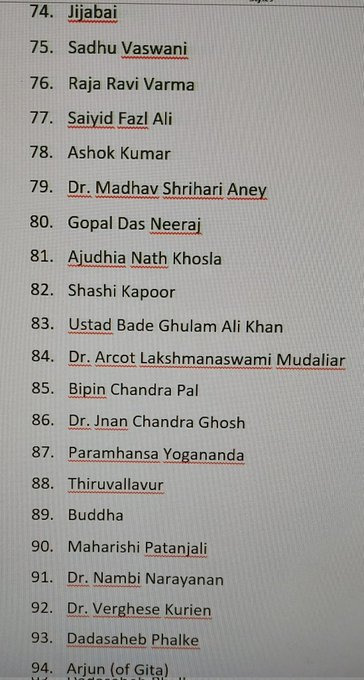
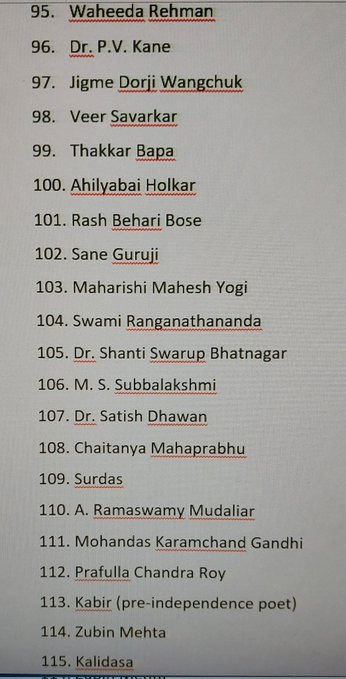



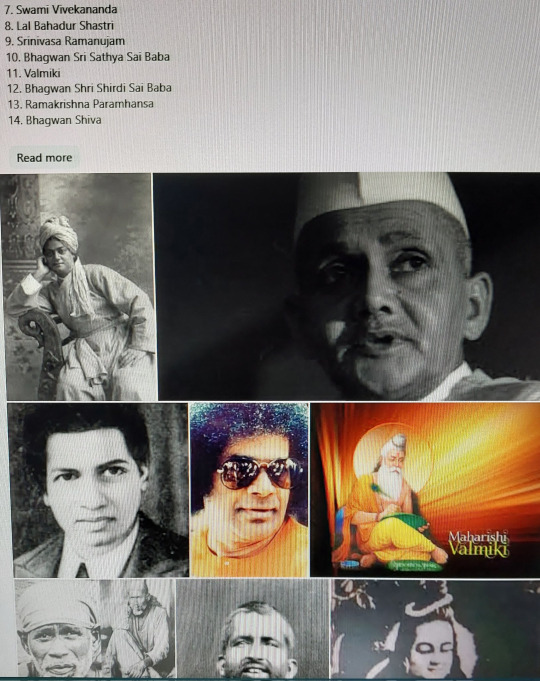




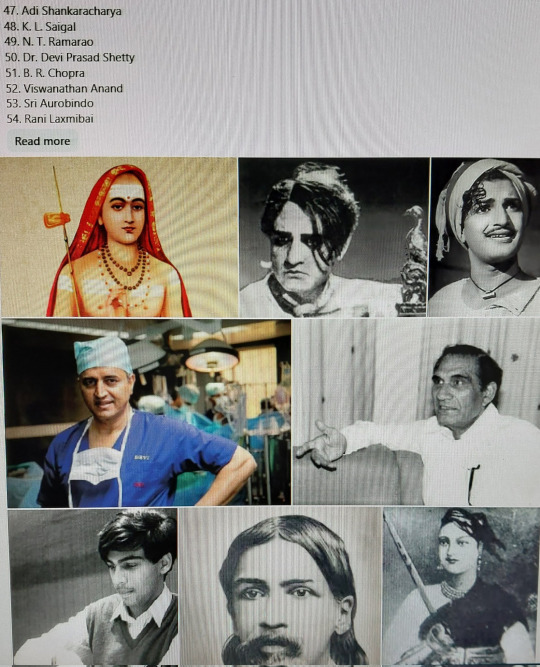




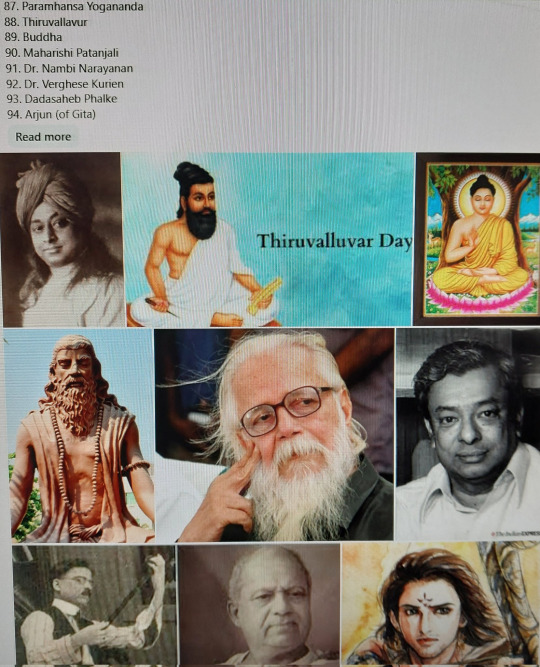
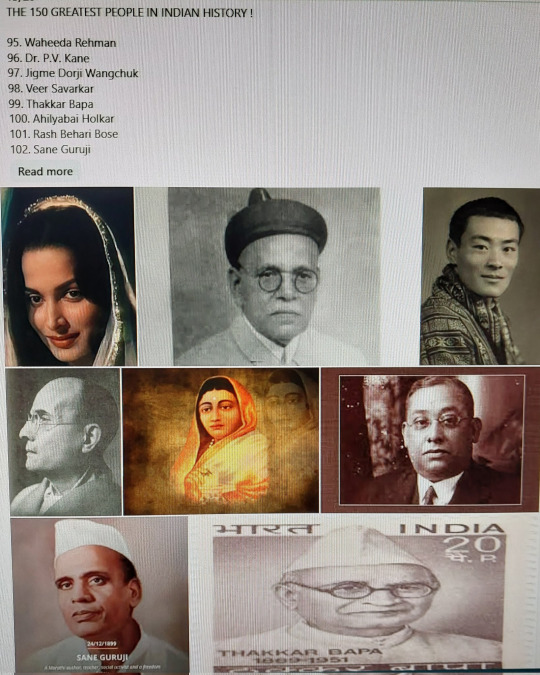


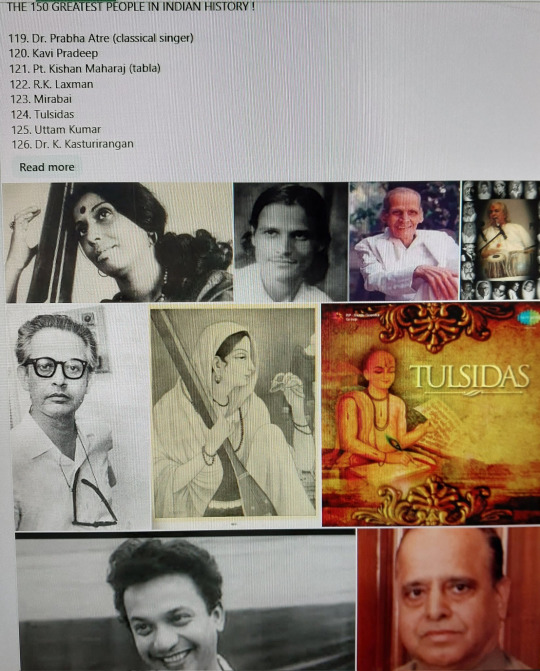



2 notes
·
View notes
Video
youtube
Tukaram Maharaj Gatha Abhang 181 ठायींची ओळखी । येईल टाकुं टाका सुखीं ॥ ...
#youtube#sant tukaram maharaj gatha abhang ram shri jagadguru charan तुकाराम गाथा अभंग vithal haripath bhajan
0 notes
Text

बोलावा विठ्ठल , पहावा विठ्ठल |
करावा विठ्ठल जीवभाव ||
Translation + Meaning : (May I) speak (of) Vitthala. (May I) see Vitthala (in everything I do). May I merge myself (become one) with Vitthala.
~ Abhang of Sant Tukaram Maharaj.
🪷 || रामकृष्ण हरी || 🪷
****
Tags : @harinishivaa @nirmohi-premika @vibishalakshman @kaal-naagin @krishna-sahacharini
105 notes
·
View notes

